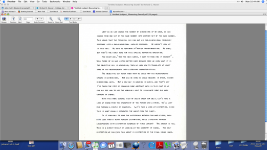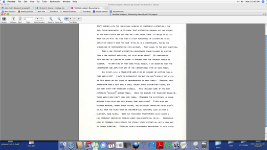A mutual search for truth requires that all parties have the same ideas about truth (e.g. that it cannot be private), significantly overlapping prior knowledge (which seems to be lacking in some cases) and agreeement on how potential truth can be tested (often lacking).
Given that a mutual search for truth appears to be impossible, we can merely hope to extend prior knowledge and remind people that truth cannot be private. Simply achieving progress for the latter would be helpful.
Sadly, people of good will on both sides of a discussion can get deflected by 'fans' (from both sides) popping up and sharing their ignorance.
Given that a mutual search for truth appears to be impossible, we can merely hope to extend prior knowledge and remind people that truth cannot be private. Simply achieving progress for the latter would be helpful.
Sadly, people of good will on both sides of a discussion can get deflected by 'fans' (from both sides) popping up and sharing their ignorance.
That maybe true but don't forget that for each 'opponent' in a discussing there are 10''s or 100''s of lurkers who are not directly involved and much more receptive to rational arguments. So it is still worthwhile to debunk the BS.
Sure Jan and thanks for pointing this out!
George
Only for the old style DIP devices, SMD SOIC and QFN /QFP packages are pretty painless when sat/stood on, I have tested this myself and sat on a random op-amp in a SOIC package for over an hour without any complaint from my derriere...😉
lol But everyone knows real op-amps are DIP so they can be easily 'rolled' by the faithful.Only things that can be plugged in can be improved on (power cords etc) 😀
Well I sort of hope that if you continue to come up with reasoned, consistent arguments backed up with facts and figures, eventually people will grok it. But maybe not; we have some recent events in the world that seem to contradict that.
So what would be the solution then?
Jan
I don't know the answer. A lot depends on personality types. A lot of good, recent social science work has been done to better understand the underlying problems, but subsequent work on solutions is still in very early phases. A couple of good books about the problems are "The Righteous Mind" and "Thinking Fast and Slow." Some very interesting later work showing what volunteers can do when working together online part of the time and working alone most of the time to predict future events in world geopolitics is "Superforecasting." Naturally, the research is funded by the government, but Wall Street sure wants in on the technology. The results have been pretty amazing.
'Music' can be considered: multi-dimensional, as it has multi frequencies, instantaneous changes in level, varying rise-time, etc. A sine wave is single-dimensional, and this could make a difference. My design for ST was based on the fact (at the time) that no known IC could give low enough distortion at 100KHz to be used.
BTW John, earlier you posted about the AIM, PIM, TIM vices of feedback circuits. You were probably joking, no?
I mean, ever since Bob Cordell build his purpose-designed AIM/PIM/TIM test equipment 30 years ago it has been known to those 'in the know' that any circuit, with or without feedback, generates AIM, PIM, TIM; and that the smart application of feedback can easily make for lower levels of PIM, AIM, TIM than in a no-feedback amp.
So in reality things are just the opposite as you said, therefor I guess you were pullung our collective leg?
Don't tell me you were not aware of those results! 🙁
Jan
I mean, ever since Bob Cordell build his purpose-designed AIM/PIM/TIM test equipment 30 years ago it has been known to those 'in the know' that any circuit, with or without feedback, generates AIM, PIM, TIM; and that the smart application of feedback can easily make for lower levels of PIM, AIM, TIM than in a no-feedback amp.
So in reality things are just the opposite as you said, therefor I guess you were pullung our collective leg?
Don't tell me you were not aware of those results! 🙁
Jan
I don't necessarily believe in Bob Cordell's results. I believe in Ron Quan's results, that are newer and more detailed. Of course, there are exceptions where a design can make extra problems due to some design choice, but negative feedback DOES create TIM, and perhaps PIM. That I know for sure. Of course, I might NOT be in the 'know', as I just design circuits for a living.
I believe in Ron Quan's results, that are newer and more detailed.
His results don't support your hypothesis at all with respect to modern op-amps. It's only the old standby audiophile circuits that have PIM and TIM or of course 741's. Bob's presentation was very carefully done unless you or a member of your posse can actually grok a technical argument to challenge them your belief in one over the other takes on religious aspects.
Sadly my take is that technology has moved on and you decided not to follow, learn, etc., we all respect your accomplishments this does nothing but make for bad feelings.
Last edited:
I don't necessarily believe in Bob Cordell's results. I believe in Ron Quan's results, that are newer and more detailed. Of course, there are exceptions where a design can make extra problems due to some design choice, but negative feedback DOES create TIM, and perhaps PIM. That I know for sure. Of course, I might NOT be in the 'know', as I just design circuits for a living.
The fact that you design circuits for a living doesn't make you any less wrong. There is no TIM/PIM issue in modern op-amps.
I'm still wondering how distortion at 100K is valid in home audio. But i don't design circuits so what do i know. I can say i've owned a few dozen amps over the decades, all kinds including a few tube ones. The best i've heard yet are the My-Ref FE mono blocks i'm currently using. Modern composite chip amps are stunning when designed well.
I don't necessarily believe in Bob Cordell's results. I believe in Ron Quan's results, that are newer and more detailed. Of course, there are exceptions where a design can make extra problems due to some design choice, but negative feedback DOES create TIM, and perhaps PIM. That I know for sure. Of course, I might NOT be in the 'know', as I just design circuits for a living.
Except that Ron's results largely match Bob's.
Yes, feedback can generate TIM etc., and non-feed back amps even more so.
Jan
Modern composite chip amps are stunning when designed well.
Never used the "stunning" myself to describe audio equipment. Some retailers have used it a lot in that context. Of those, some seem to have toned it down more recently. I use a Bryston 4B. Not perfect maybe, but I figure it's good enough not to go replacing with the latest greatest.
Here is a 'touch' of the late Richard Heyser. He is where I got my original ideas about this from.
The second two read a little UI wasn't that what California was all about then?
EDIT - Before anyone misinterprets my comment it's a shoot from the hip writing style in stark contrast to his AES technical articles nothing more nothing less IMHO.
Last edited:
Never used the "stunning" myself to describe audio equipment. Some retailers have used it a lot in that context. Of those, some seem to have toned it down more recently. I use a Bryston 4B. Not perfect maybe, but I figure it's good enough not to go replacing with the latest greatest.
Good amp (going by it's reputation) way more power than i need or could use. I did the test like a number of us on here. Turned out most days i use less than 5W per channel, sometimes i push it up to around 30 but only when she is out 😀
Richard Heyser worked at JPL then, do you think he was OK in that job?
Probably, what that has to do with his casual audio musings is your own interpretation. Sadly the dead can neither add nor subtract from their legacy.
Not at all. I remember our conversations over the years, especially from '68-75' where he said essentially the same thing, AND he wrote a series of articles about his perception of the 'geometry' of sound. He was much more radical than even I am today.
JPL has employed some understanding Negative Feedback Theory too
another with the JPL endorsement: Dr. Boris J. Lurie's Homepage: Classical Feedback Control
not likely to find much comfort for Curl, Hansen style mis representations, mistaken claims about Negative Feedback in Lurie's work
another with the JPL endorsement: Dr. Boris J. Lurie's Homepage: Classical Feedback Control
Prior to retirement, Boris J. Lurie, Ph. D., Sc. D., was Senior Staff Member in the Guidance and Control Analysis Group, Jet Propulsion Laboratory, California Institute of Technology. He designed spacecraft attitude control and instrument control systems for several spacecraft including Cassini, STRV, Mars Pathfinder, DS-1, and Chemistry, and received many NASA awards.
Previously, he designed RF feedback amplifiers and telecommunication systems at TRW and other companies, and taught nonlinear system stability and oscillation, feedback control, network synthesis, and RF and analog electronics at several universities.
His publications include over 100 papers, 9 patents and 8 books on application of feedback in telecommunication systems and control, and on feedback amplifiers. The most recent books are:
Classical Feedback Control with MATLAB and Simulink 2nd ed. written with Dr. Paul J. Enright, CRC Press, 2012, and Feedback Maximization, Artech House, 1986.
not likely to find much comfort for Curl, Hansen style mis representations, mistaken claims about Negative Feedback in Lurie's work
Last edited:
- Status
- Not open for further replies.
- Home
- General Interest
- Everything Else
- What is wrong with op-amps?


